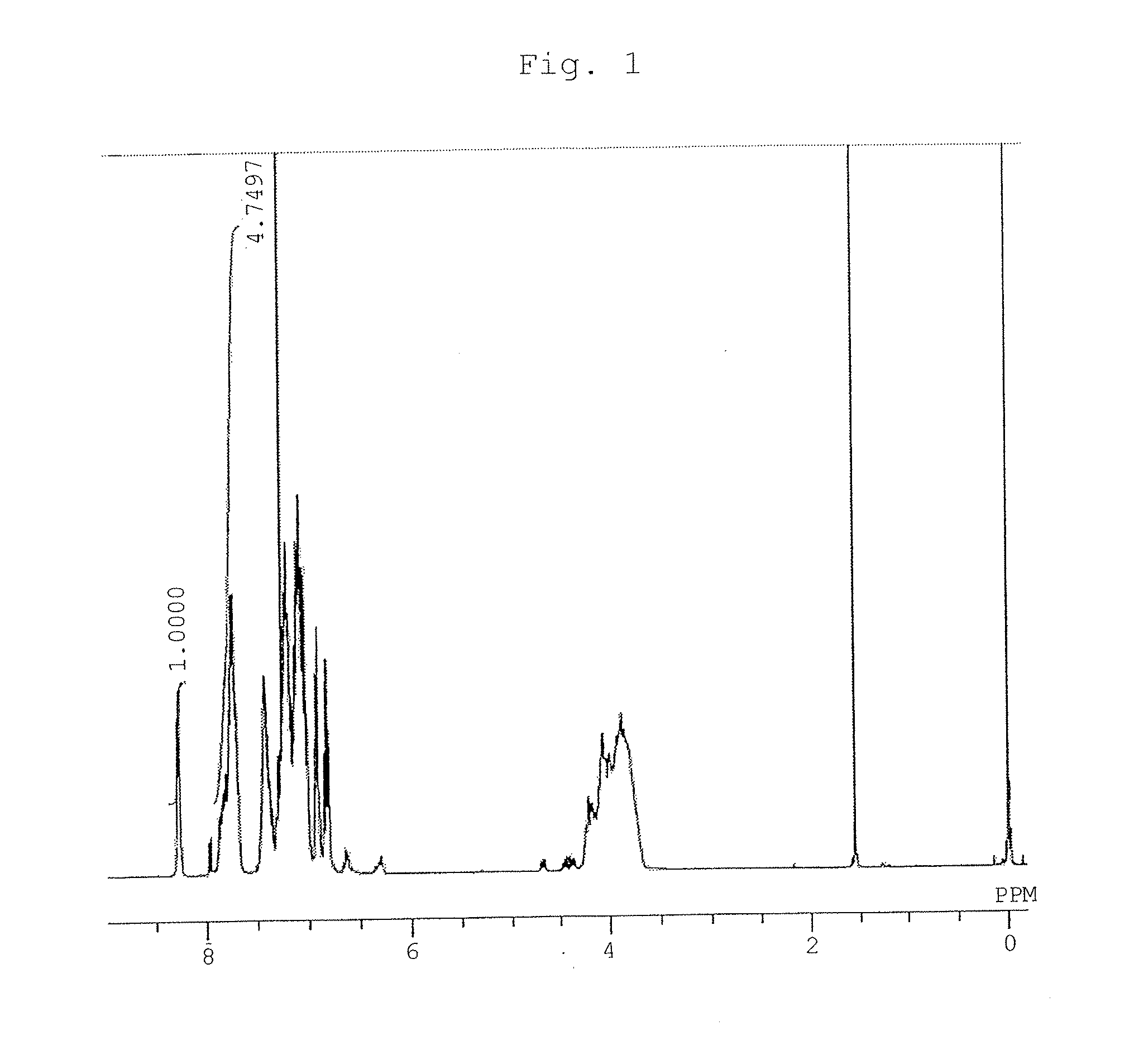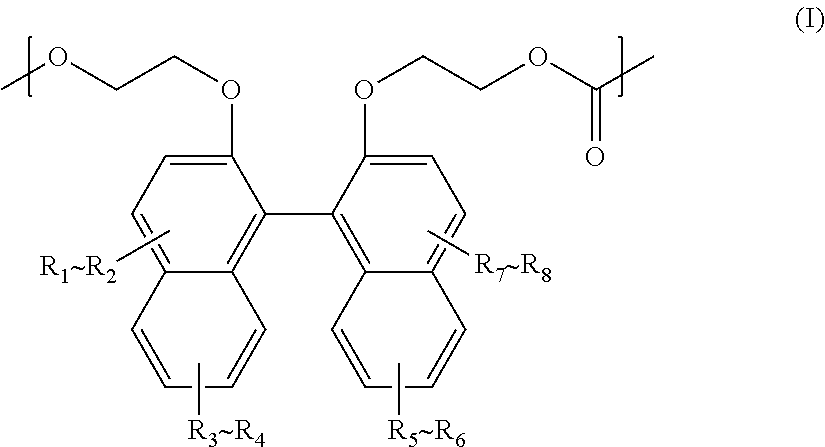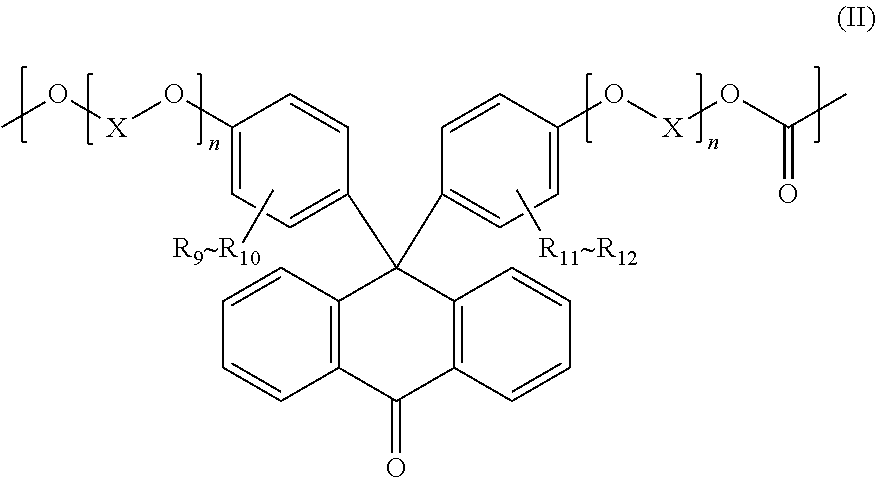Polycarbonate and optical member comprising the same
a technology of polycarbonate and optical member, applied in the direction of optical elements, instruments, optics, etc., can solve the problems of poor moldability, low moisture resistance of polyethylene, inferior moldability of copolycarbonate, etc., and achieve high refractive index, low birefringence, and high transparency
- Summary
- Abstract
- Description
- Claims
- Application Information
AI Technical Summary
Benefits of technology
Problems solved by technology
Method used
Image
Examples
reference example 1
[0099]374.44 parts by weight of 1,1-bi(2-(2-hydroxyethoxy)naphthalene (may be abbreviated as “BL-2EO” hereinafter), 222.79 parts by weight of diphenyl carbonate (DPC) and 1.82×10−2 part by weight of tetramethylammonium hydroxide were put into a reaction oven equipped with a stirrer and a distillation unit, heated at 180° C. under normal pressure in a nitrogen atmosphere and stirred for 20 minutes. Thereafter, the pressure was reduced to 20 to 30 kPa over 20 minutes and the temperature was raised to 260° C. at a rate of 60° C. / hr to carry out a transesterification reaction. Then, while the temperature was kept at 260° C., the pressure was reduced to 0.13 kPa or less over 120 minutes to carry out a polymerization reaction under agitation at 260° C. and 0.13 kPa or less for 1 hour.
example 1
[0100]Polymerization was carried out at 260° C. and 0.13 kPa or less in the same manner as in Reference Example 1 except that 355.72 parts by weight of BL-2EO, 18.92 parts by weight of 10,10-bis(4-hydroxyphenyl)anthrone (may be abbreviated as “BP-ANT” hereinafter) and 222.79 g of DPC were used and the reaction time was changed to 0.5 hour.
[0101]The polycarbonate had a BL-2EO / BP-ANT molar ratio of 95:5, a specific viscosity of 0.260 and a Tg of 123° C.
[0102]After the obtained polycarbonate was vacuum dried at 123° C. for 4 hours, 0.050% of bis(2,4-dicumylphenyl)pentaerythritol diphosphite and 0.10% of pentaerythritol tetrastearate were added based on the weight of the obtained polycarbonate composition, and the obtained product was pelletized by means of a vented single-screw extruder having a screw diameter of 30 mm. The obtained pellet had satisfactory moist heat resistance and a specific viscosity retention after a moist heat test of 95%.
example 2
[0103]Polymerization was carried out at 260° C. and 0.13 kPa or less in the same manner as in Reference Example 1 except that 337.00 parts by weight of BL-2EO, 37.84 parts by weight of BP-ANT and 222.79 g of DPC were used and the reaction time was changed to 0.5 hour.
[0104]The polycarbonate had a BL-2EO / BP-ANT molar ratio of 90:10, a specific viscosity of 0.250 and a Tg of 125° C.
[0105]After the obtained polycarbonate was vacuum dried at 120° C. for 4 hours, 0.050% of bis(2,4-dicumylphenyl)pentaerythritol diphosphite and 0.10% of pentaerythritol tetrastearate were added based on the weight of the obtained polycarbonate composition, and the obtained product was pelletized by means of a vented single-screw extruder having a screw diameter of 30 mm. The obtained pellet had satisfactory moist heat resistance and a specific viscosity retention after a moist heat test of 93%.
PUM
| Property | Measurement | Unit |
|---|---|---|
| Temperature | aaaaa | aaaaa |
| Thickness | aaaaa | aaaaa |
| Thickness | aaaaa | aaaaa |
Abstract
Description
Claims
Application Information
 Login to View More
Login to View More - R&D
- Intellectual Property
- Life Sciences
- Materials
- Tech Scout
- Unparalleled Data Quality
- Higher Quality Content
- 60% Fewer Hallucinations
Browse by: Latest US Patents, China's latest patents, Technical Efficacy Thesaurus, Application Domain, Technology Topic, Popular Technical Reports.
© 2025 PatSnap. All rights reserved.Legal|Privacy policy|Modern Slavery Act Transparency Statement|Sitemap|About US| Contact US: help@patsnap.com



